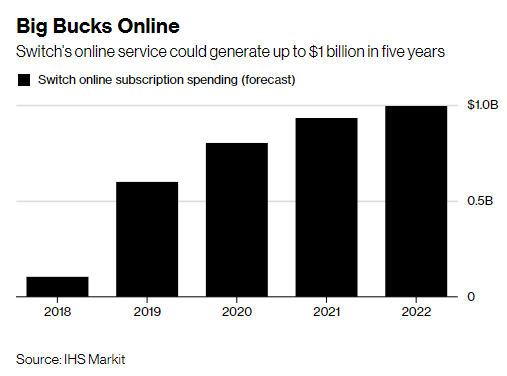On September 19, the official launch of the Nintendo online service took place. Bloomberg journalist Yuji Nakamura analyzed in detail why the new service caused a flurry of criticism. We present a short version of the material in Russian.

Yuji Nakamura
The company that created Super Mario and Zelda has finally taken up online.
The debut of her first online subscription service, which charges $20 per year from Switch users for the opportunity to play with each other, took place. This step took place more than a decade after the launch of similar products by its competitors — Sony and Microsoft.
Nintendo’s move was met with boos, not applause. The reason is that users had 18 months to try the service for free. And they weren’t thrilled. They swore at the lack of mandatory functionality for modern multiplayer projects (for example, in-game chat), the inconvenience of use, the vulnerability to hacking and constant connection problems.
“Nintendo is at least five years behind, perhaps even more,” if we compare its service with Sony and Microsoft solutions, says Piers Harding—Rolls, head of gaming research at IHS Markit.

Switch online service can start earning $1 billion a year from its online service in five years
In June, the chief of Nintendo’s American division, Reggie Fils-Aime, stated that the company was still “learning how to build a technical infrastructure.”
Then he promised that the problems would be fixed before the official launch.
“You should be prepared for difficulties when you do such things. When you launch games, this can always happen,” Fils-Aim said at the time.
Nintendo has long ignored online gaming for both philosophical and financial reasons.
The fact is that the company has gained credibility thanks to games designed for single-player passage, as in the case of Zelda and Metroid, or for playing with one device, as in Mario Kart.
Plus, the problem was the cost of building an online infrastructure for a company that was conservative from a financial point of view. But today, multiplayer is a significant part of the $138 billion gaming industry and the Kyoto—based company had no choice.
To make a platform similar to Sony, you need to invest in servers around the world and constantly improve the network so that the connection speed does not lag behind the development and growth of the user base.
Sony’s network has evolved since its launch in 2000 and in the last five years the company has been spending a lot on it. This includes investments in servers that support cloud gaming as part of the PlayStation Now service. And over the last fiscal year, the company’s network business earned more than $9 billion.

Sony’s quarterly revenue from online gaming grows after the improvement and introduction of new services
Nintendo has abandoned this approach.
Instead, she chose a cheaper one — a peer-to-peer network (P2P).
“With P2P, since the players are essentially connected to each other, the speed of the game is limited by the weakest connection. So if one of them has a weak Internet connection, the whole game will work slowly,” explained Penny de Byl, founder of the educational provider of online games Holistic3d. — “Nintendo should take care of dedicated servers, or the players will leave.”
The key advantage of P2P is that it is cheaper to build and maintain it. It cost Nintendo ⅓ of the cost of similar solutions from Sony and Microsoft.
Users also raise a question about the functionality of the service, or rather about what it lacks. The Nintendo system turned out to be unable to communicate by voice and exchange messages, forcing it to use an application for mobile devices. Matchmaking is inconvenient. At the same time, players also complain about the archaic code system for adding friends. Players have not yet had the opportunity to surf the web and watch videos, and this is a key feature for those who watch competitions on services like Twitch.
Recently, players also found themselves dissatisfied with the fact that the in-game process is not automatically saved in the cloud for all titles. This means that if a player loses and breaks the Switch, the hours they spent in games will be lost.
“You see, online is not in the genes of Nintendo,” says Serkan Toto, founder of the Tokyo—based gaming consulting agency Kantan Games.
But despite the criticism, players still use the online service. Digital sales of the platform jumped 68% in the last quarter compared to the same result a year earlier. And although the end of the free period may upset players, this is a necessary first step,” says Harding—Rolls from IHS. The constant cash flow will help Nintendo invest in the further development of the system and respond to the concerns of players. “That’s why Nintendo had to start taking money,” Harding—Rolls says.
For a company that has traditionally been on the side of gamers, the main challenge will be to keep their favor and calm the critics.
Earlier this year, a player who was annoyed by the constant online cheating in the blockbuster Splatoon 2 hacked the game himself, got to the top in the standings for July and left one simple message: “Please add an anti-cheat.”
Nintendo, confused, banned the user and deleted the message. Since then, many sources have reported that the company is quietly trying to work on the problem.
The next major test for the system after launch this week will be the release of Super Smash Bros. Ultimate on the seventh of December. A bad launch will not just hurt sales of Nintendo’s most important game this year, but will increase pressure from securities traders playing down. Their skepticism towards Switch as a long-running story is now becoming more and more.
Photo: Luke Sharett/BloombergSource: Bloomberg
